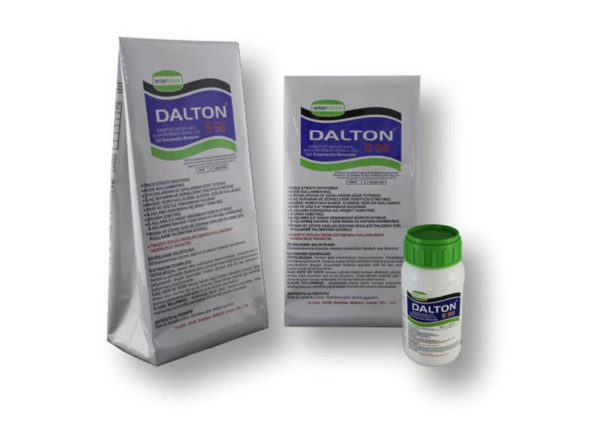

Explanation
APPLICATION PREPARATION AND USE
Drug Effect:
Emamectin Benzoate is highly effective on leaf-fed Lepidopter larvae and blocks nerve impulses in the larvae. In this case, the feeding of the larvae stops immediately and they become paralyzed. DALTON 5 SG is a strong stomach poison and has a contact effect.
Preparation of the drug for application:
The required amount of drug is mixed with a small amount of water in a suitable container. Two-thirds of the water-filled mixer is added into the working spraying tank by mixing. The tank is then completed with water. Calibration is done first to calculate the amount of water to be used per decare. For this, a certain amount of water is put into the tank of the tool and it is calculated by running at a constant speed in the field conditions, how much area can be wetted with the existing water. From here, how much water will be spent per decare is calculated with the calibrated tool. The nozzles of the sprayer should be checked and cleaned.
Usage of the drug:
Pepper (Greenhouse, Field), Cucumber (Greenhouse), Eggplant; Spraying should be done when 1-2 newly opened egg packages or 4-5 larvae are seen in 100 plants. Spraying should be done before the larvae on the leaf are dispersed.
Tomato (Greenhouse); Spraying starts immediately when 5 of 100 plants are dishes.
Bond; Spraying against the bunch moth is directed according to the forecast and warning system. The number of butterflies caught in the sexually attractive traps reaches the peak point and starts to fall, the afternoon temperatures in the first generation exceed 15ºC for two consecutive days and show continuity, the total of effective temperatures is 120 gd (day degrees) in the 1st generation, 520 gd in the 2nd generation, and in the 3rd stage Spraying is carried out by following 1047 gd, the vine is phenologically in the 1st period, flower bud, in the 2nd generation, in the beginning of the sweetening period in the 3rd, and the first larvae exit from the eggs. One spraying is done in each fertilization. However, since ovulation can continue from the 3rd pound, spraying is continued by taking into account the duration of the drug and the harvest date as long as new eggs are found.
Cotton; Spraying is started when the first green wolf larvae are detected and spraying is repeated at 10-15 day intervals according to new infections.
INFORMATION ABOUT RESISTANCE
The plant protection product named DALTON 5 SG is an insecticide classified as Group 6 according to its mechanism of action. Repetitive applications of plant protection products with the same mechanism of action promote resistance development. For this reason, in order to delay resistance development, do not exceed total recommended number of applications of DALTON 5 SG in the same season. In cases where the application should be repeated, pay attention to the use of plant protection products with a different mechanism of action (except for Group 6).
MIXTURE STATUS
DALTON 5 SG can be mixed with many insecticides and fungicides. It is recommended to perform a physical miscibility test with the drug to be used as a mixture before wide applications.
POISONING SYMPTOMS
Growth in the eyeballs, uncontrolled movement of the muscles, muscle tremor.
FIRST AID MEASURES
In case of poisoning, take the first aid measures mentioned below. Call a doctor, take the packaging and label of the plant protection product together.
In case of Skin Contact; See: Precautionary Statements (P302 + P352)
In Eye Contact; See - Precautionary Statements (P305 + P351 + P338) If Inhaled; See Precautionary Statements (P304 + P340)
If Swallowed; Medical intervention should be applied immediately. If swallowed, drink a glass of water. Try to induce vomiting only in accordance with the doctor's instructions. Nothing should be given to the unconscious patient by mouth, or vomiting should not be attempted.
ANTIDOTE and TREATMENT
It has no special antidote. Treat symptomatically and supportive therapy.
HAZARDOUS EXPRESSIONS (H)
H301: Toxic if swallowed.
H311: Toxic in contact with skin.
H315: Causes skin irritation.
H318: Causes serious eye damage.
H319: Causes serious eye irritation.
H331: Toxic if inhaled.
H370: Causes damage to organs.
H372: Causes damage to organs through prolonged or repeated exposure.
H400: Very toxic in the aquatic environment.
H410: Long-lasting, very toxic effect in the aquatic environment.
Precautionary Statements (P)
P271: Use only outdoors or in a well-ventilated area.
P273: Avoid release to the environment.
P302 + P352: IF ON SKIN: Wash with plenty of soap and water.
P304 + P340: IF INHALED: If it is difficult to breathe, remove the victim to fresh air and keep it in a comfortable position for easy breathing.
P305 + P351 + P338: IF IN EYES: Rinse carefully with water for several minutes. Remove contact lenses if fitted and easy to do. Continue rinsing.
P307 + P311: In case of exposure: Call the POISON CENTER or doctor / physician.
P501 Dispose of contents / container in accordance with local regulations.
EUH401: Follow the instructions for use to avoid risks to human health and the environment.
PLANT AND HAZARDOUS ORGANISMS TO BE USED
| Plant Name | Harmful Organism Name | Application Dose and Period | Time Between Last Application and Harvest |
| Pepper (Greenhouse) | Cotton leafworm
(Spodoptera littoralis) |
30 g/da
Larva |
7 day |
| Tomato (Greenhouse) | Green wolf
(Helicoverpa armigera) |
30 g /100 L water
Larva |
7 day |
| Cucumber (Greenhouse) | Cotton leafworm
(Spodoptera littoralis) |
30 g/100 L water
Larva |
7 day |
| Eggplant | Cotton leafworm
(Spodoptera littoralis) |
30 g /100 L water
Larva |
7 day |
| vineyard* | Vineyard cluster moth
(Lobesia botrana) |
25 g/100 L water
Larva |
7 day |
| Cotton | Green wolf
(Helicoverpa armigera) |
40 g/da
Larva |
7 day |
(*) It is not used in vineyards where harvesting vine leaves will be harvested.
Sosyal Ağ